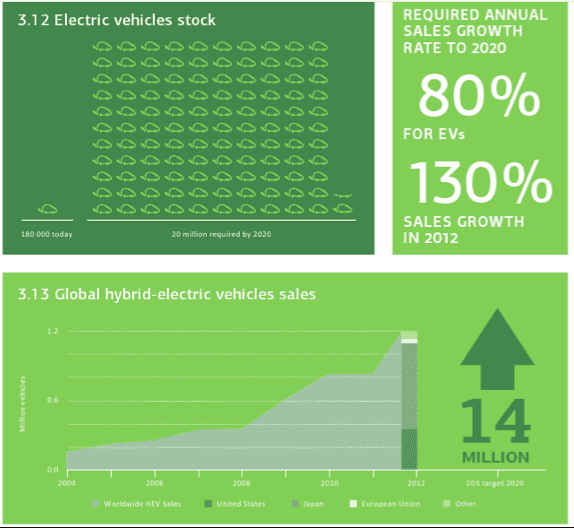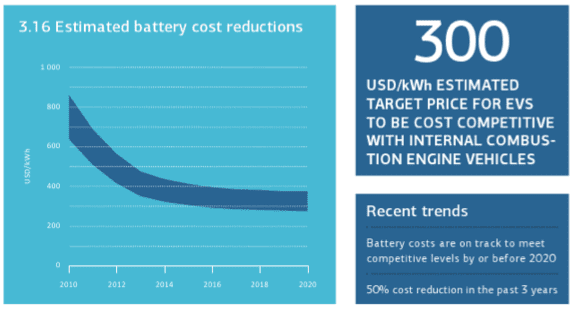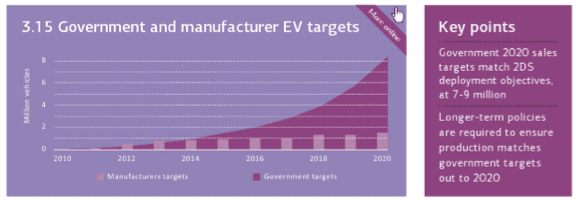20 Million EVs By 2020 To Help Us Stay Below 2°C
This article originally appeared on RenewEconomy.
By Sophie Vorrath
Can global electric vehicle sales jump from around 100,000 in 2012 to 7 million a year by the end of the decade? That’s just one of the goals set by the International Energy Agency as part of a suite of clean energy measures aimed at limiting global warming to a best-case scenario of 2°C. And according to the IEA, it’s a goal within reach – as long as we have the right government policies, improved EV infrastructure and significantly lower battery costs.
According to its report, Tracking Clean Energy Progress 2013, released today, the IEA’s 2°C scenario (2DS) target of 20 million EVs by 2020 means the rate of global sales growth must increase by 80 per cent per year.
 Chip in a few dollars a month to help support independent cleantech coverage that helps to accelerate the cleantech revolution!
Chip in a few dollars a month to help support independent cleantech coverage that helps to accelerate the cleantech revolution!
“This represents a rapid market introduction for EVs, at 10 per cent of total light-duty vehicle sales by 2020,” says the report. “This progress to 2020 is essential to set EV deployment on course for a more substantial role in the post-2025 period: the 2DS assumes stronger displacement of conventional internal combustion engine (ICE) vehicles from the mid-2020s, with the EV share increasing sharply to half of new vehicles sales by 2050, together with fuel-cell vehicles.”
The good news is that, going by current sales growth rates, we’re on the right track for the 2020 target: around 100,000 plug-in hybrid-electric vehicles (PHEVs) and full-battery electric vehicles (BEVs) were sold globally in 2012 – more than double (130%) the number sold in 2011, the first year of widespread market introduction.
The not-so promising caveat, however, is that in order to maintain, or even build, on this momentum, the IEA warns that governments must continue and expand policies such as vehicle price incentives; including rebates or tax credits on vehicles, purchase subsidies, or exemptions from vehicle registration taxes or license fees. And EV battery prices, which have already halved over the past three years, must be cut by another 50 per cent.
The report says the ongoing cost reductions in battery development in 2012 had been “dramatic,” with prices dropping to around $US500-600/kWh by the end of the year. As an indication of what is to come, the IEA quotes US Department of Energy estimates that battery development costs are now at $US485/kWh of useable energy (not including profit or warranty costs).
But the IEA estimates battery costs must be further reduced to around $US300/kWh to achieve cost parity with conventional cars, and to below $300/kWh to make EV ownership attractive enough to consumers to boost EV market penetration. “This last part of the cost curve is likely to be the hardest to scale,” says the report.
As for policy, the report points out that many countries have set ambitious targets for EV deployment by 2015-20 which, cumulatively, now match or exceed 2DS deployment objectives. But it also notes that this indicator of growing government ambition does not necessarily translate to more ambitious manufacturer production targets.
For this to happen, says the IEA report, manufacturers need clear and stable incentive frameworks “with a timeframe long enough to ensure adequate return on investment,” rather than the current standard timeframes of only one or two years.
The report also notes that 2012 also saw a breakthrough in charging technology for EVs – “a vital measure to boost consumer confidence and lessen anxiety over vehicle range” – with Volvo’s development of a three-phase, on-board, fast EV charger, set to come onto the market this year. With a charge time of 1.5 hours, the charger operates six times as fast as current on-board devices.
The report also cites Tesla Model S being named 2013 Car of the Year by the American magazine Motor Trend as another “milestone for public confidence” in EVs, marking the first time a non-gasoline powered vehicle has received the award. The Chevy Volt/Ampera also succeeded the BEV Nissan LEAF as the European Car of the Year.
Have a tip for CleanTechnica? Want to advertise? Want to suggest a guest for our CleanTech Talk podcast? Contact us here.
Latest CleanTechnica.TV Video

CleanTechnica uses affiliate links. See our policy here.




